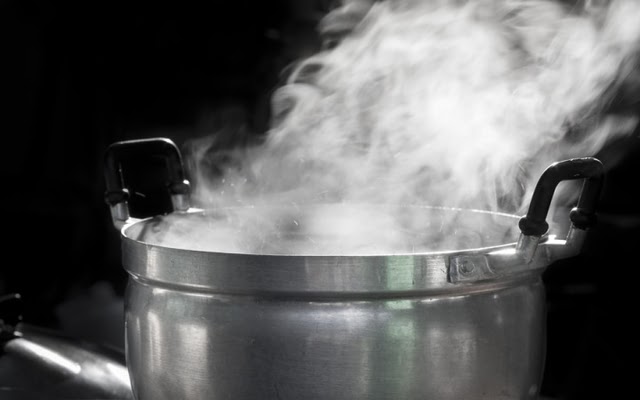
Did you notice any fog this morning when you woke up? If there was no fog outside, there is a possibility that there was fog inside!
Did you have a cup of hot chocolate for breakfast? Maybe your parents had a steaming cup of coffee? What about when you took a shower? Did the warm water create foggy conditions in your bathroom?
Have you ever wondered why there is foggy steam around hot water? Some of our Wonder Friends have asked the same question, so today we will explore the science behind the fog that often surrounds hot water.
If you have ever helped make spaghetti for dinner, you have probably seen boiling water in a large pot on the stove. When the water in the pot reaches a temperature of 212º F (100º C), it starts to boil. The liquid water turns into gas, and you can see lots of bubbles and steam rising into the air.
So, the foggy steam you see above a pot of boiling water can be explained by science. But what about the foggy “steam” you see above a hot cup of coffee or in the air around a hot shower? The water in these cases is well below the boiling point, otherwise you wouldn’t be able to drink or bathe in it. So what is happening?
The scientific process of evaporation is what is happening! Evaporation is the process in which liquid water changes into water vapor in the air, as part of the water cycle. Although evaporation is slower than boiling, it speeds up as the water gets hotter and gains energy.
Molecules of water in liquid form are constantly moving and colliding with each other, transferring kinetic energy in the process. Occasionally, the molecules at the surface gain enough energy to escape from the water and enter the atmosphere. This is evaporation.
As water heats up, more energy is involved, allowing more molecules to reach the point where they can escape into the atmosphere. Evaporation still only occurs at the surface, but it happens faster as the water temperature rises.
At the boiling point, there is enough kinetic energy in the liquid water for any water molecule to escape into the atmosphere, regardless of whether it is on the surface or not. This is why you see rapid bubbling and the release of steam from a boiling pot of water.
However, the atmosphere can only hold a certain amount of water vapor. At a certain point, known as the dew point, the atmosphere becomes saturated and cannot hold all the water vapor. Some of it condenses back into liquid water.
This is what happens in your shower and above your hot cup of coffee. Some of the liquid that is evaporating causes the atmosphere directly above it to reach the dew point. Some of the water vapor condenses back into tiny droplets of liquid water, which you see as fog or “steam.”
Try It Out
Wasn’t today’s Wonder of the Day full of interesting scientific information? Keep the fun going by trying one or more of the following activities with a friend or family member:
Turn your learning into something delightful!
Boil a kettle of water on the stove and prepare a piping hot beverage of your choice for your loved ones. Are they coffee enthusiasts? How about indulging in some hot chocolate? Or maybe they prefer a nice cup of tea? Whatever their preference, brew a few cups and savor the warmth of this delightful treat!
Transform your bathroom into a steamy laboratory!
Next time you take a shower or bath, take a moment to explore the settings of the hot water. Be cautious not to burn yourself, but gradually turn up the hot water and observe as steam fills the air. How foggy does your bathroom become? Where does the water start to condense? Does it fog up the mirror? Share your steamy findings with a friend or family member and explain the science behind it!
Create Evaporation with a simple experiment using hand sanitizer!
If you have some hand sanitizer on hand, you can engage in a fun experiment that demonstrates evaporation. Follow the instructions below and give it a try. Share the process with a friend or family member. Can they guess what’s happening? Enjoy the experience of experimenting and enlightening your loved ones about the wonders of science!





Leave a Reply